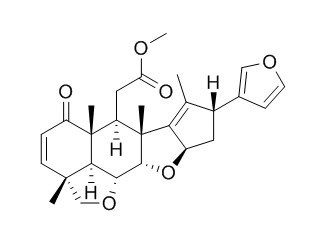28-Deoxonimbolide
28-Deoxonimbolide exhibits potent cytotoxic activity against HL60 leukemia cells.
Inquire / Order:
manager@chemfaces.com
Technical Inquiries:
service@chemfaces.com
Tel:
+86-27-84237783
Fax:
+86-27-84254680
Address:
1 Building, No. 83, CheCheng Rd., Wuhan Economic and Technological Development Zone, Wuhan, Hubei 430056, PRC
Providing storage is as stated on the product vial and the vial is kept tightly sealed, the product can be stored for up to
24 months(2-8C).
Wherever possible, you should prepare and use solutions on the same day. However, if you need to make up stock solutions in advance, we recommend that you store the solution as aliquots in tightly sealed vials at -20C. Generally, these will be useable for up to two weeks. Before use, and prior to opening the vial we recommend that you allow your product to equilibrate to room temperature for at least 1 hour.
Need more advice on solubility, usage and handling? Please email to: service@chemfaces.com
The packaging of the product may have turned upside down during transportation, resulting in the natural compounds adhering to the neck or cap of the vial. take the vial out of its packaging and gently shake to let the compounds fall to the bottom of the vial. for liquid products, centrifuge at 200-500 RPM to gather the liquid at the bottom of the vial. try to avoid loss or contamination during handling.
Molecules.2020, 25(9):2081.
Int J Mol Sci.2022, 23(1):538.
J Mol Med (Berl).2018, 96(7):661-672
Arch Biochem Biophys.2018, 644:93-99
Int Immunopharmacol.2019, 71:22-31
Molecules.2019, 25(1):E103
Reprod Sci.2022,10.1007/s43032-022-01117-4.
Int Immunopharmacol.2024, 143(Pt 2):113486.
Phytomedicine.2018, 41:62-66
Food Research2022, 6(6): 30-38.
Related and Featured Products
Mol Cancer Ther. 2014 May;13(5):1067-77.
Preclinical evaluation of the supercritical extract of azadirachta indica (neem) leaves in vitro and in vivo on inhibition of prostate cancer tumor growth.[Pubmed:
24674886]
Azadirachta indica, commonly known as neem, has gained worldwide prominence because of its medical properties, namely antitumor, antiviral, anti-inflammatory, antihyperglycemic, antifungal, and antibacterial activities. Despite these promising results, gaps remain in our understanding of the molecular mechanism of action of neem compounds and their potential for use in clinical trials.
METHODS AND RESULTS:
We investigated supercritical extract of neem leaves (SENL) for the following: molecular targets in vitro, in vivo efficacy to inhibit tumor growth, and bioactive compounds that exert antitumor activity. Treatment of LNCaP-luc2 prostate cancer cells with SENL suppressed dihydrotestosterone-induced androgen receptor and prostate-specific antigen levels. SENL inhibited integrin β1, calreticulin, and focal adhesion kinase activation in LNCaP-luc2 and PC3 prostate cancer cells. Oral administration of SENL significantly reduced LNCaP-luc2 xenograft tumor growth in mice with the formation of hyalinized fibrous tumor tissue, reduction in the prostate-specific antigen, and increase in AKR1C2 levels. To identify the active anticancer compounds, we fractionated SENL by high-pressure liquid chromatography and evaluated 16 peaks for cytotoxic activity. Four of the 16 peaks exhibited significant cytotoxic activity against prostate cancer cells. Mass spectrometry of the isolated peaks suggested the compounds with cytotoxic activity were nimbandiol, nimbolide, 2',3'-dihydronimbolide, and 28-Deoxonimbolide. Analysis of tumor tissue and plasma samples from mice treated with SENL indicated 28-Deoxonimbolide and nimbolide as the bioactive compounds.
CONCLUSIONS:
Overall, our data revealed the bioactive compounds in SENL and suggested that the anticancer activity could be mediated through alteration in androgen receptor and calreticulin levels in prostate cancer.
J Nat Prod. 2011 Apr 25;74(4):866-70.
Cytotoxic and apoptosis-inducing activities of limonoids from the seeds of Azadirachta indica (neem).[Pubmed:
21381696 ]
METHODS AND RESULTS:
Thirty-five limonoids, including 15 of the azadiradione type (1-15), five of the gedunin type (16-20), four of the azadirachtin type (21-24), nine of the nimbin type (25-33), and two degraded limonoids (34, 35), isolated from Azadirachta indica seed extracts, were evaluated for their cytotoxic activities against five human cancer cell lines. Seven compounds (3, 6, 7, 16, 18, 28, and 29) exhibited cytotoxic activity against one or more cell lines. Among these compounds, 7-deacetyl-7-benzoylepoxyazadiradione (7), 7-deacetyl-7-benzoylgeduin (18), and 28-Deoxonimbolide (28) exhibited potent cytotoxic activity against HL60 leukemia cells with IC(50) values in the range 2.7-3.1 μM. Compounds 7, 18, and 28 induced early apoptosis in HL60 cells, observed by flow cytometry. Western blot analysis showed that compounds 7, 18, and 28 activated caspases-3, -8, and -9 in HL60 cells.
CONCLUSIONS:
This suggested that compounds 7, 18, and 28 induced apoptotic cell death in HL60 cells via both the mitochondrial- and the death receptor-mediated pathways. Futhermore, compound 7 was shown to possess high selective cytotoxicity for leukemia cells since it exhibited only weak cytotoxicity against a normal lymphocyte cell line (RPMI 1788).
J Nat Prod. 1989 Nov-Dec;52(6):1246-51.
Spectroscopic and biological investigation of nimbolide and 28-deoxonimbolide from Azadirachta indica.[Pubmed:
2614419]
METHODS AND RESULTS:
The reisolation of nimbolide [1] from Azadirachta indica of Tanzanian origin and the isolation and structure elucidation of a new limonoid, 28-Deoxonimbolide [2], from the same plant source are reported.
CONCLUSIONS:
For the first time, unambiguous 1H- and 13C-nmr assignments of compounds 1 and 2 are presented, as well as their in vitro cytotoxic activity against human tumor cell lines.



